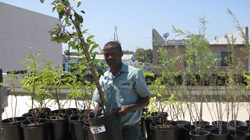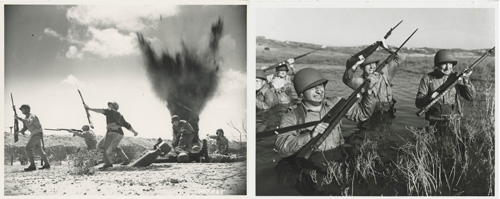|
Tree Planters Unearth UC San Diego’s Military Past
Colleen Sheehan | May 17, 2010
Two weeks ago, on an undeveloped hillside on the UC San Diego campus, Aimable Nininahazwe’s shovel struck a metal object while he was planting a tree, unearthing a remnant of the university’s military past.
Within minutes, a campus hazardous materials expert, campus police and the chief of the San Diego Fire Department’s bomb squad surrounded a rusty cylinder about the size of a soda can. Two U.S. Marines Corps ordnance-disposal technicians were called to the hillside south of a student housing development at 1 Miramar St.
David Briggs, an explosive disposal expert with HydroGeoLogics Inc., carefully transferred the cylinder to a safe location away from the tree planters. The Marines ordinance disposal experts determined that the rusty shell didn’t pose a danger and transported it to Air Station Miramar for X-rays and further examination. Nininahazwe later learned that he had dug up a World War II-vintage 75-millimeter shell.
Nininahazwe had no idea his tree planting would result in an explosives investigation. He is one of dozens of young local residents employed by the Urban Corps of San Diego County. UC San Diego partnered with the Urban Corps to secure a $106,000 grant from the California Department of Forestry and Fire Protection, or CalFire, to plant 848 trees on campus this spring. Founded in 1989, the Urban Corps provides job training and educational opportunities in the fields of conservation, recycling and community service for young adults aged 18 to 25.
Nininahazwe was voted the 2009 Corps Member of the Year by the Urban Corps staff for his dedicated work with the organization’s Weatherization Energy Efficient Rehabilitation and Healthy Homes programs. He recently began planting trees with the Urban Corps’ Urban Forestry Program. Born in Tanzania, he speaks several languages and aspires to be a Navy doctor. During Nininahazwe’s two years with Urban Corps, he earned a high school diploma, which he will receive in June.
Inspections and Metal Detectors
From 1917 to 1964, part of today’s 1,200-acre UC San Diego campus was Camp Matthews, a rifle-training camp for more than 1 million recruits and shooters. The U.S. Army's Camp Callan, located west of Camp Matthews on the Torrey Pines Mesa, served as an anti-aircraft artillery training center during World War II.

Aimable Nininahazwe, an employee of the Urban Corps of San Diego County, had no idea a tree-planting project at UC San Diego would unearth a piece of the university’s military past.
In 2007, the U.S. Army Corps of Engineers inspected the former 400-acre Camp Matthews property for unexploded ordnance and discarded military munitions. In a report, inspectors concluded that additional munitions debris may exist on or around undeveloped sections of the site. This report prompted the development of UC San Diego’s Formerly Used Defense Site (FUDS) munitions awareness program, which requires the campus to retain explosives-disposal experts to ensure safety whenever work is performed in undeveloped, defined ranges of interest on campus.
As required, the university this spring contracted with HydroGeoLogic Inc. to scan the planned tree-planting area with metal detectors and remove any ordnance-related debris they found. Since implementation of the FUDS program, the discovery of the 75-millimerter shell was the first incident to prompt a full response resulting in ordnance removal by military munitions experts.
Tending an Urban Forest
Recognized as a National Arbor Day Foundation Tree Campus USA University for the past two years, UC San Diego is dedicated to sustainable forest management. The university’s 129-acre urban forest contains more than 200,000 trees, but each year about 350 of them are lost to storms, disease, insect infestation or old age.
“Although UC San Diego is a leader in innovative sustainability research and education, something as low-tech as our campus forest can have a significant impact on our financial and ecological resources,” said Gary Matthews, UC San Diego’s vice chancellor of resource management and planning.
Samuel Oludunfe, UC San Diego’s campus urban forester, is especially pleased about this year’s additions to the campus forest. “It’s clearly tree planting with a difference, a purpose and an exciting twist this year,” said Oludunfe, who worked with Urban Corps to obtain the CalFire grant.
Trees provide a variety of important benefits to the campus:
- Trees help cut the cost of heating and cooling campus buildings.
- They capture nearly 10,000 tons of carbon dioxide, 5 percent of campus greenhouse gas emissions.
- Campus trees trap and filter nearly 140 million gallons of storm water runoff and reduce soil erosion.
- The trees on campus absorb an estimated 73 tons of air pollutants, improving San Diego’s air quality.
- The campus forest provides habitat for more than 100 species of birds, small mammals and migrating monarch butterflies.
- The trees also save the university an estimated $2.2 million in annual facilities operations and infrastructure maintenance costs.
The Urban Corps team is continuing to plant 5-gallon, container-grown native coast live oak, Mesa oak, California sycamore and Torrey pine trees on the campus. As in the past, all tree-planting areas on FUDS sites are scanned with metal detectors prior to planting.
Ordnance Debris Converted to Scrap Metal

Before UC San Diego’s founding in 1960, a portion of university's 1,200 acres was part of the U.S. Marine Corps’ Camp Matthews, which was used by riflemen and other soldiers in-training.
“We treat all potential munitions and explosives of concern with care and evaluate them for their ability to cause harm,” said Tod Ferguson, campus hazardous materials business plan manager. “When an item is discovered, we enlist expert analysts to determine if the item is potential munitions of explosive concern or unexploded ordnance.”
Most ordnance-related debris discovered on campus — primarily spent lead from small arms practice fire and fragmented debris from practice hand grenades and mortar fire — is verified to be inert and processed as scrap metal. Items containing potentially harmful chemical remnants are processed as hazardous waste and disposed of by certified vendors. The most significant ordnance discoveries include a single 3.5-inch rocket found during construction of the La Jolla Medical Center in 2003, and six inert 3.5-inch rockets and five 2.36-inch rockets found during a housing construction project in 2008, Ferguson said.
UC San Diego’s Environment, Health and Safety Department advises anyone who finds what could be military debris to step away from it and immediately call campus police at (858) 534-4357. Callers are asked to describe the object and give directions to the location.

|